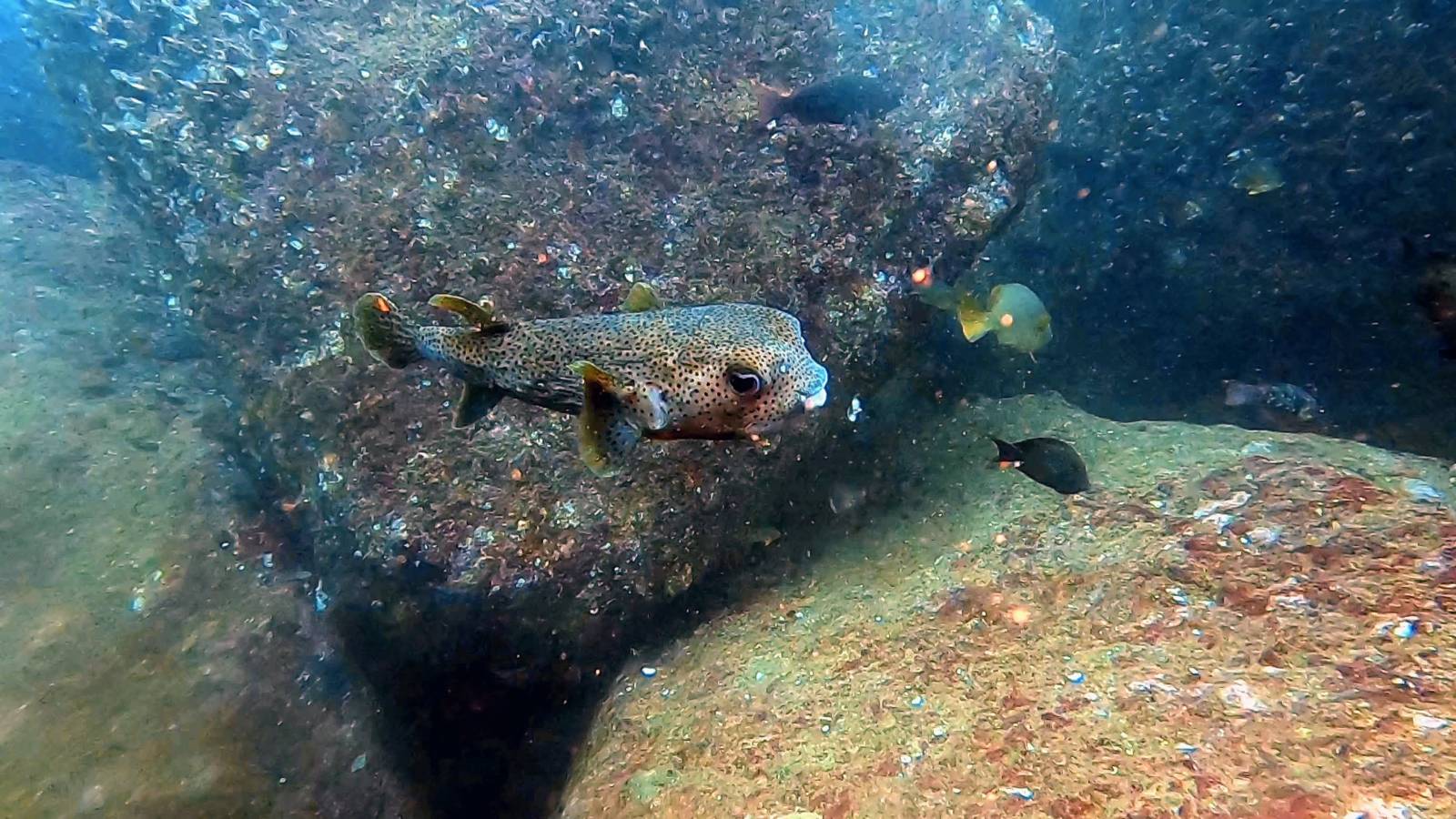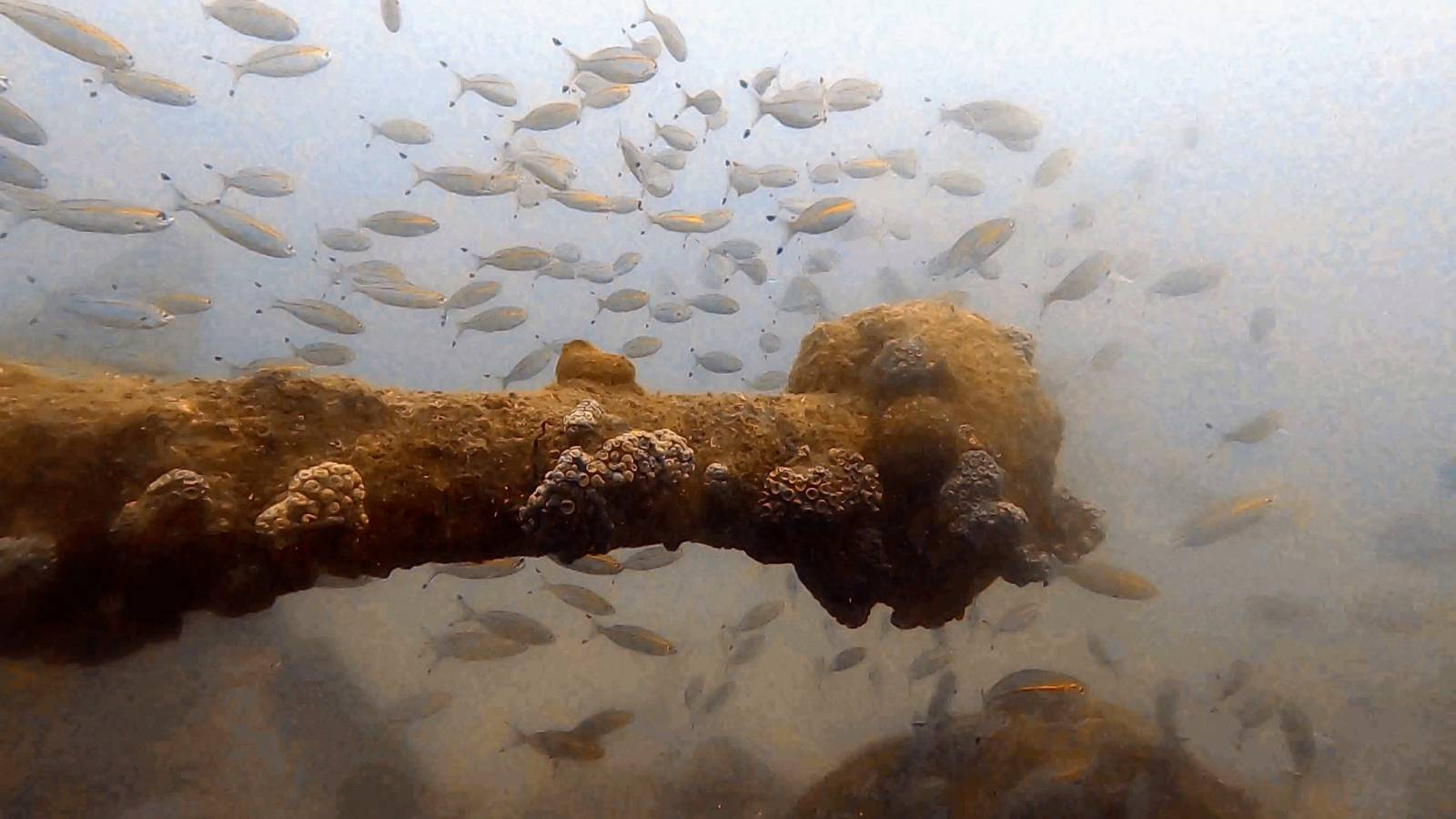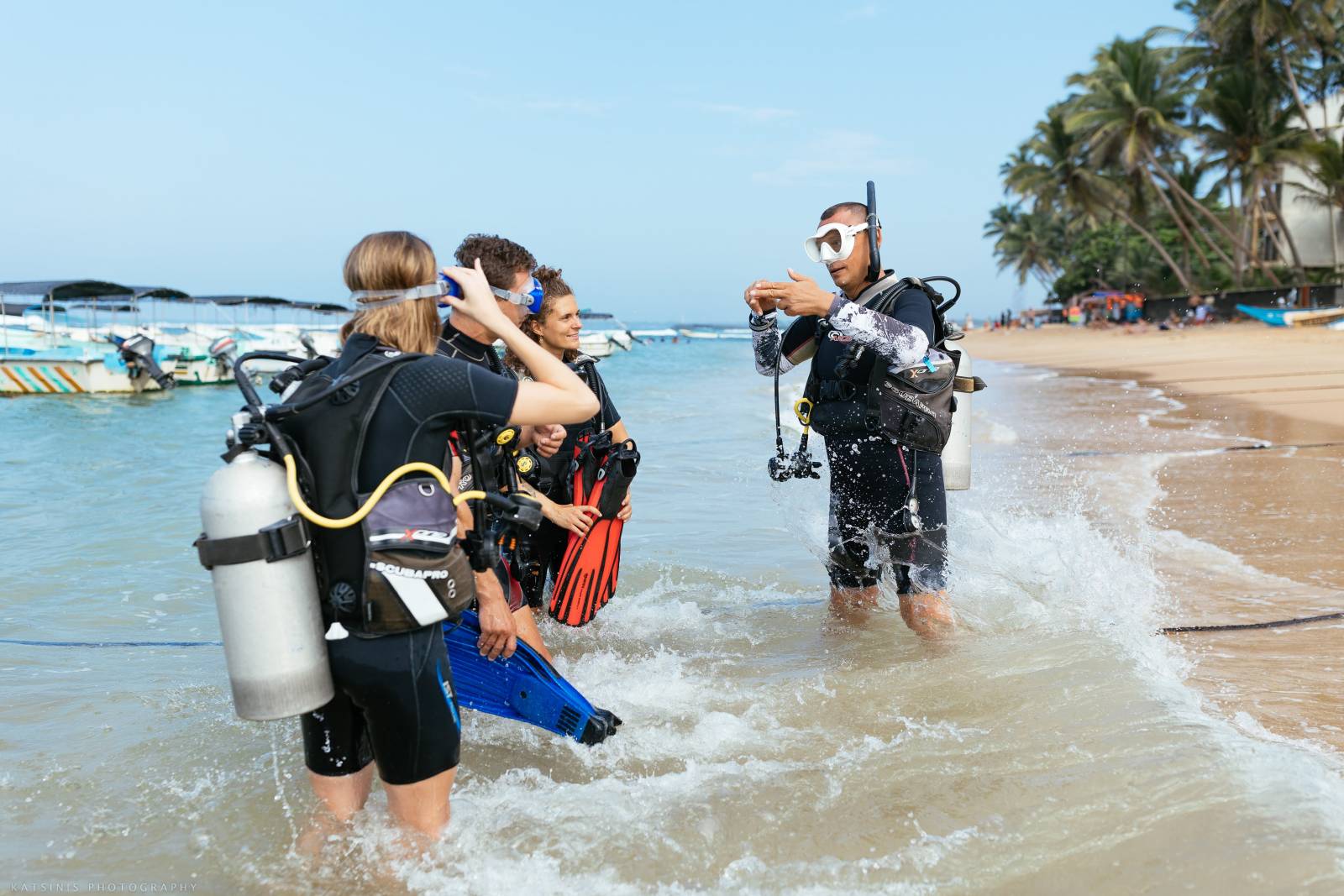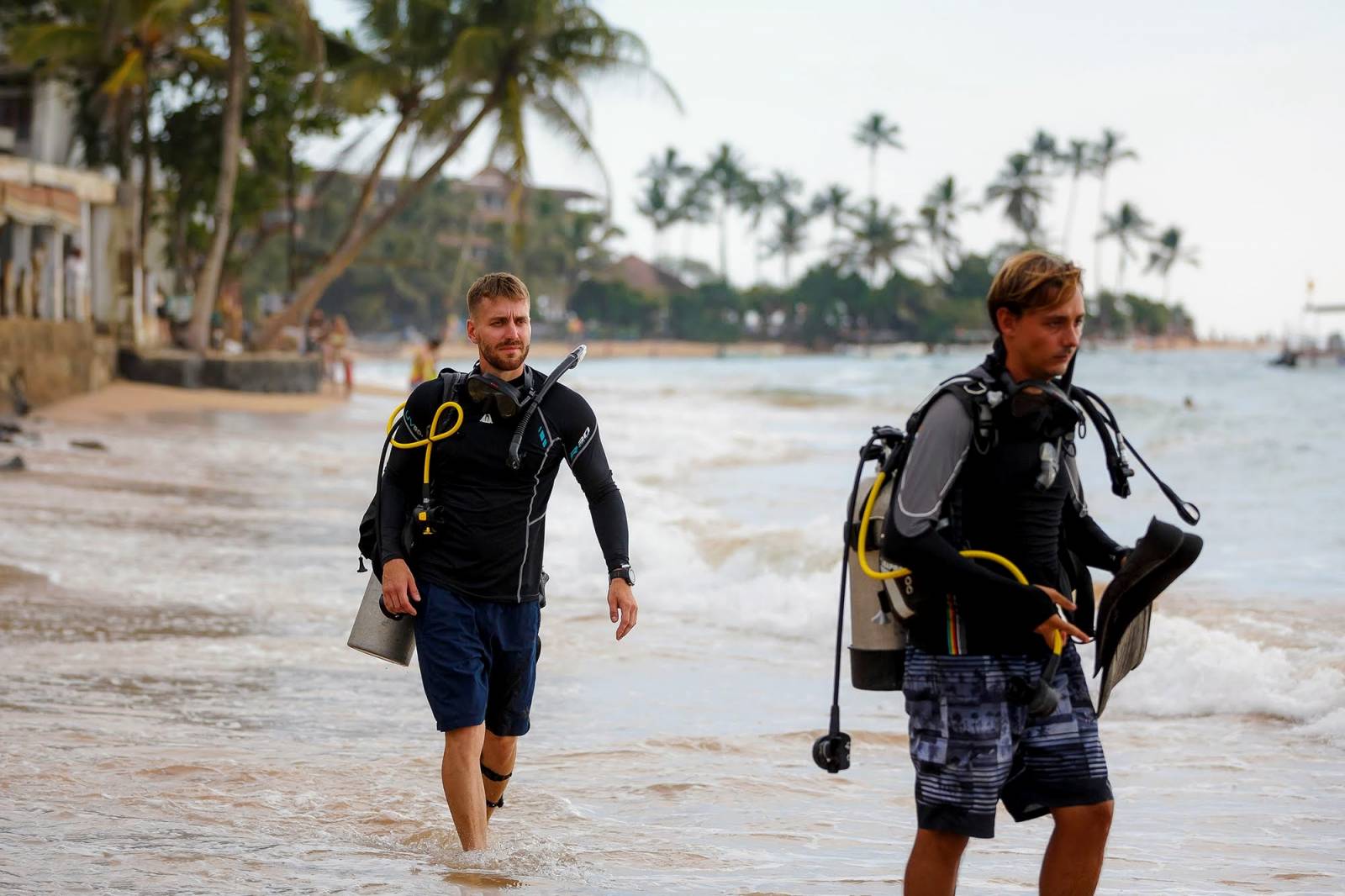Sri Lanka, the tropical paradise in the Indian Ocean, is emerging as an enticing diving destination with a wealth of underwater wonders waiting to be explored. Home to an array of marine life, stunning coral reefs, and historical shipwrecks, this island nation offers a unique diving experience. With its diverse diving locations and favorable climate, Sri Lanka promises unforgettable adventures beneath the surface for divers of all skill levels.
The Best Time to Dive in Sri Lanka
The best time to dive in Sri Lanka depends on the region you plan to visit, as the country experiences two distinct monsoon seasons affecting the east and west coasts differently. Here's a general overview of the best diving conditions for each coast:
West and South Coasts (including Hikkaduwa, Unawatuna, and Weligama):
The ideal diving season along the west and south coasts typically runs from November to April. During this period, you can expect calm seas, clear waters, and excellent visibility, ranging from 15 to 30 meters (49 to 98 feet). The weather is generally dry and sunny, making it a popular time for tourists and divers alike.
East Coast (including Trincomalee, Batticaloa, and Pigeon Island):
The best time to dive on the east coast is from May to October when the region experiences calm seas and good visibility. The monsoon rains on this coast generally occur between November and February, so it's best to avoid planning your diving trip during this time.
It's important to note that specific marine life sightings, such as whales or manta rays, may vary depending on the season and location. For example, blue whales and sperm whales are commonly sighted off the southern coast of Sri Lanka between December and April, while on the east coast, the best time for whale watching is from May to September.
When planning your diving trip to Sri Lanka, consider the regional weather patterns and diving conditions to ensure the best possible experience. Additionally, it's a good idea to check with local dive centers and operators for up-to-date information on current conditions and marine life sightings.
Top Dive Sites in Sri Lanka
Sri Lanka boasts a plethora of dive sites, each with its own unique attractions. Here are five of the most popular sites worth exploring:
Hikkaduwa Marine Park: Located on the southwest coast, Hikkaduwa Marine Park is home to stunning coral gardens teeming with colorful fish and marine life. Ideal for beginner divers, this park offers shallow dives and excellent snorkeling opportunities.
Unawatuna Bay: Situated near Galle, Unawatuna Bay is famous for its rich coral reefs and diverse marine life, including turtles and reef sharks. With varying depths, this site caters to divers of all skill levels.
Pigeon Island Marine Sanctuary: Off the coast of Trincomalee, this marine sanctuary is home to vibrant coral reefs, abundant fish species, and blacktip reef sharks. With shallow waters and calm conditions, Pigeon Island is perfect for beginners and snorkelers.
The Great Basses Reef: Located off the southeastern coast, this remote reef is famous for its underwater rock formations, large pelagic fish, and seasonal migration of whales. Suitable for advanced divers, the Great Basses Reef offers thrilling drift dives and spectacular marine life encounters.
The British Sergeant Shipwreck: Sunk during World War II, this British oil tanker rests at a depth of 15-32 meters (50-105 feet) off the coast of Trincomalee. The wreck is now a thriving artificial reef, attracting diverse marine life and offering a unique dive experience for intermediate and advanced divers.
Wreck Diving in Sri Lanka
The waters surrounding Sri Lanka are home to numerous shipwrecks, each with a fascinating history. These wrecks, originating from trade routes, World War II, and maritime accidents, offer divers a glimpse into the past. Notable wreck dive sites include the SS Conch, HMS Hermes, and Taprobane East Wreck. For a safe and enjoyable wreck diving experience, proper training and certifications are essential.
Preserving Sri Lanka's Marine Life and Ecosystem
As divers, it's crucial to adhere to responsible diving practices and eco-friendly guidelines. Local organizations and government agencies have made significant efforts to protect Sri Lanka's marine life and ecosystems through the establishment of marine sanctuaries. To minimize environmental impact and promote sustainable diving, divers should follow established guidelines and maintain a strong sense of environmental stewardship.
Dive Centers and Accommodations
Reputable dive centers and schools are essential for ensuring a safe and enjoyable diving experience. Look for centers affiliated with PADI or SSI, as they adhere to high-quality training and safety standards. Some recommended dive centers in Sri Lanka include:
- Dive For You (Hikkaduwa)
- Unawatuna Diving Centre (Unawatuna)
- Ocean Front Diving Centre (Trincomalee)
- Poseidon Diving Station (Nilaveli, near Pigeon Island)
- Divinguru (Tangalle, near Great Basses Reef)
In addition to choosing a reputable dive center, selecting the right accommodations can enhance your diving experience. Sri Lanka offers a wide range of lodging options, from budget-friendly guesthouses to luxury resorts, often located in close proximity to popular dive sites. Some recommendations include:
- Hikka Tranz by Cinnamon (Hikkaduwa)
- Thaproban Pavilion Resort and Spa (Unawatuna)
- Anilana Nilaveli (Trincomalee)
- Jungle Beach by Uga Escapes (near Pigeon Island)
- Ranna Beach Villa by Fox Resorts (Tangalle)
How much does it cost to dive in Sri Lanka?
The cost of diving in Sri Lanka can vary depending on factors such as the dive center, location, and the type of dive or course you choose. Here's a rough estimate of prices for common diving activities in Sri Lanka:
- Fun dives: A single guided fun dive typically costs between $30 and $50, depending on the location and dive site. If you plan to do multiple dives or book a dive package, the price per dive may decrease, offering better value.
- Discover Scuba Diving / Try Diving: Introductory dive experiences for beginners who are not certified usually range from $60 to $100. This includes a brief theory session, confined water training, and a supervised open water dive.
- Open Water Diver certification course: The entry-level certification course, which allows you to dive independently with a buddy, typically costs between $350 and $500. This includes all training materials, equipment rental, and certification fees.
- Advanced and specialty courses: Advanced courses like the Advanced Open Water Diver, Rescue Diver, or specialty courses such as wreck diving or underwater photography can vary in price, ranging from $200 to $500, depending on the course content and duration.
These prices are approximate and may vary depending on the dive center, location, and time of year. It's important to remember that the cheapest option isn't always the best choice. Prioritize factors such as safety, quality of instruction, and equipment maintenance when selecting a dive center or operator.
Additionally, keep in mind that some dive centers may charge extra for equipment rental, dive site entry fees, or transportation costs. It's a good idea to confirm what's included in the price when booking your dives or courses to avoid any surprises.
Sri Lanka's unique diving opportunities, from vibrant marine life and beautiful coral reefs to fascinating historical shipwrecks, make it an unforgettable destination for divers. By choosing the right dive center, accommodations, and adhering to responsible diving practices, you can uncover the underwater treasures of this tropical paradise and create lasting memories. So, pack your dive gear and embark on a journey to explore the enchanting underwater world of Sri Lanka.
Upd: Answers to your questions about diving in Sri Lanka
Are there wrecks near Hikkaduwa available for diving?
Yes, there are a few sunken ships near Hikkaduwa that are available for diving. The most notable ones are:
Earl of Shaftesbury: This British sailing ship, also known as the "Hikkaduwa Gala Wreck," sank in 1847 after hitting a rock. It lies at a depth of approximately 12-18 meters (40-60 feet) and is suitable for divers of various skill levels. The wreck is now covered with beautiful corals and surrounded by a variety of marine life, making it an interesting dive site.
SS Conch: Although this shipwreck is located closer to Unawatuna, it's still accessible from Hikkaduwa. The SS Conch was a British oil tanker that sank in 1903 and now lies at a depth of about 21 meters (70 feet). The wreck has become an artificial reef, attracting various marine species, including schools of fish and reef sharks.
Hikkaduwa Fishery Harbor Wreck: This is a small fishing trawler that was deliberately sunk in 2000 to create an artificial reef. The wreck lies at a depth of around 30 meters (98 feet) and is suitable for intermediate and advanced divers. The site has a thriving marine ecosystem, with colorful coral growth and an abundance of fish species.
Please note that while these wrecks are accessible from Hikkaduwa, local conditions and exact locations may change over time. It's essential to consult with a reputable local dive center to get the most up-to-date information on dive sites and ensure a safe diving experience.
Can I dive if I wear glasses or contact lenses?
Yes, you can dive if you wear glasses or contact lenses. However, you will need to consider alternative options to accommodate your vision needs while underwater. Here are a few solutions:
- Prescription dive masks: Prescription dive masks are customized with corrective lenses that match your prescription. They can be ordered through specialized dive shops or online retailers. Both single vision and bifocal lenses are available, ensuring that you can see clearly underwater. Note that prescription dive masks can be more expensive than regular masks, but they are a worthy investment if you dive frequently.
- Soft contact lenses: Many divers wear soft contact lenses under their dive masks. Soft contact lenses generally do not cause any issues while diving, as they adhere closely to the eyes. However, it's essential to close your eyes if you need to clear your mask or during mask removal and replacement exercises to avoid losing your contacts.
- Disposable contact lenses: Using disposable contact lenses for diving is another option, especially if you're concerned about losing them underwater. If a lens is lost or becomes contaminated with water, you can simply replace it with a new one after the dive.
- Gas permeable (hard) contact lenses: Although some divers use gas permeable contact lenses while diving, they might not be the best option. These lenses may cause discomfort due to the pressure changes underwater and are more likely to dislodge than soft contact lenses.
It's always a good idea to consult with your optometrist or ophthalmologist before diving with contact lenses. They can provide personalized advice based on your specific needs and type of lenses.
What certifications do I need to start diving?
To start diving, you need to obtain an entry-level scuba certification from a recognized scuba diving training organization, such as PADI (Professional Association of Diving Instructors), SSI (Scuba Schools International), or NAUI (National Association of Underwater Instructors), among others. The entry-level certifications are often referred to as "Open Water Diver" or "Scuba Diver" courses. These certifications enable you to dive independently with a buddy to a maximum depth of 18 meters (60 feet) for PADI and SSI or 20 meters (66 feet) for NAUI.
The Open Water Diver course typically includes:
- Knowledge development: This component covers basic scuba diving principles, such as dive planning, dive table usage, equipment selection, and safety guidelines. You can complete this portion through online learning, classroom sessions, or independent study using a course manual.
- Confined water dives: You will learn and practice essential scuba diving skills in a controlled environment, such as a swimming pool or shallow, calm water. This includes equipment setup, underwater communication, mask and regulator clearing, buoyancy control, and emergency procedures.
- Open water dives: You will apply the skills learned during confined water dives in an open water environment, such as the ocean or a lake, under the supervision of an instructor. Typically, four open water dives are required to complete the certification process.
It's essential to choose a reputable dive center or instructor affiliated with a recognized training organization to ensure that you receive proper training and adhere to established safety standards. After obtaining your entry-level certification, you can continue to develop your skills and knowledge by pursuing advanced and specialty certifications, such as Advanced Open Water Diver, Rescue Diver, and various specialties like deep diving, wreck diving, or underwater photography.
Diving without certification
Indeed, if you want to experience scuba diving without committing to a full certification course, many dive schools offer "Discover Scuba Diving" or "Try Diving" programs. These introductory experiences allow you to dive under the direct supervision of a professional instructor without needing a certification. However, there are limitations to diving without certification:
- Depth: Introductory dives are typically limited to shallow depths, usually not exceeding 12 meters (40 feet). This is to ensure your safety and comfort as a beginner without prior experience.
- Dive sites: The dive sites selected for these introductory dives are generally easy and beginner-friendly, with good visibility and minimal currents. Challenging dive sites, such as deep or wreck dives, are usually not accessible to non-certified divers.
- Supervision: When participating in a Discover Scuba Diving or Try Diving program, you are required to dive with a certified instructor at all times. You cannot dive independently or with a buddy without obtaining a proper certification.
These introductory programs are an excellent way to familiarize yourself with the underwater world and basic diving skills. They often include a brief theory session, followed by a confined water dive to practice essential skills, and finally, an open water dive under the guidance of an instructor. If you enjoy the experience and wish to continue diving, you can then pursue a full certification course, such as the Open Water Diver, to dive independently and explore a broader range of dive sites.
What is the difference between PADI, SSI, and other dive certification agencies?
PADI (Professional Association of Diving Instructors), SSI (Scuba Schools International), and other dive certification agencies, such as NAUI (National Association of Underwater Instructors) and CMAS (Confédération Mondiale des Activités Subaquatiques), are organizations responsible for setting standards and certifying scuba divers and instructors. While they all aim to promote safe and enjoyable diving experiences, there are some differences between them in terms of their teaching methodologies, materials, and course structures.
PADI: As the largest and most recognized scuba diving certification agency worldwide, PADI offers a wide range of courses and certifications for recreational and professional divers. PADI courses follow a modular structure with standardized training materials, such as manuals, videos, and online learning platforms. PADI instructors have some flexibility in teaching, but they are required to adhere to the organization's prescribed standards.
SSI: SSI is another major global scuba diving certification agency. Their training approach is more flexible compared to PADI, emphasizing a personalized, student-centered learning experience. SSI instructors have more leeway to adapt their teaching methods based on individual students' needs and progress. SSI courses often integrate digital materials, such as online learning platforms and interactive apps.
NAUI: NAUI is one of the oldest scuba diving certification agencies, with a strong emphasis on dive safety and education. Their training approach focuses on building competent, confident divers with a solid understanding of diving theory and skills. NAUI courses tend to offer more in-depth knowledge development and emphasize practical application, with instructors having significant flexibility to tailor the courses based on students' needs.
CMAS: As an international federation of national diving organizations, CMAS certifies divers through its affiliated member organizations. Their course structure is more standardized, with a star-rating system (1-star, 2-star, and 3-star) indicating different skill levels. CMAS courses are generally more focused on building strong foundational skills, and the organization is known for its involvement in competitive and technical diving.
Despite the differences in teaching approaches and course structures, the fundamental diving principles and skills taught by these organizations are similar. All of these certification agencies are recognized internationally, so your certification from any of them will enable you to dive worldwide. When choosing a dive center or instructor, it's essential to prioritize their reputation, safety record, and quality of instruction rather than solely focusing on the certifying agency.
Is scuba diving safe, and what are the risks involved?
Scuba diving, when practiced responsibly and following established safety guidelines, is generally considered safe. However, like any sport or recreational activity, there are inherent risks involved. Some of the potential risks and hazards associated with scuba diving include:
- Decompression sickness (DCS): Also known as "the bends," decompression sickness occurs when nitrogen bubbles form in the bloodstream and tissues as a result of rapid changes in pressure during ascent. To minimize the risk of DCS, divers should follow safe ascent rates, adhere to no-decompression limits, and perform safety stops.
- Barotrauma: Barotrauma refers to injuries caused by pressure changes, affecting air-filled spaces in the body, such as ears, sinuses, and lungs. To avoid barotrauma, divers should equalize the pressure in their ears and mask during descent and ascent, and avoid diving with congestion or respiratory issues.
- Oxygen toxicity: Breathing high partial pressures of oxygen can lead to oxygen toxicity, which can cause convulsions and loss of consciousness. This risk is more common in deep or technical diving using enriched air nitrox or mixed gases. Proper gas management and adhering to maximum operating depths help mitigate this risk.
- Drowning: Although rare, drowning can occur if a diver loses consciousness or experiences equipment failure, such as running out of air. Regular equipment checks, maintaining adequate air supply, and diving within your limits can reduce this risk.
- Marine life injuries: Encounters with marine life can sometimes lead to injuries from bites, stings, or punctures. Maintaining a safe distance from wildlife, avoiding contact with the marine environment, and wearing exposure protection can help prevent these incidents.
- Getting lost or separated: Divers can become disoriented or separated from their buddy or group, leading to panic and potential accidents. Using underwater navigation techniques, maintaining visual or physical contact with your buddy, and carrying signaling devices can help mitigate this risk.
To ensure a safe and enjoyable diving experience:
- Obtain proper training and certification from a reputable organization.
- Conduct regular equipment checks and maintenance.
- Dive within your limits and skill level.
- Follow safe diving practices and adhere to established guidelines.
- Choose a reputable dive center or operator with a good safety record.
- Maintain your physical fitness and stay healthy.
By taking these precautions and following safety protocols, you can minimize the risks associated with scuba diving and enjoy a safe and rewarding underwater experience.
What marine life can I expect to encounter while diving in Sri Lanka, and how should I interact with them?
Sri Lanka offers a rich and diverse marine life due to its strategic location in the Indian Ocean. When diving in Sri Lanka, you can expect to encounter a wide variety of marine species, including:
- Coral reefs: Sri Lanka is home to many coral reefs, hosting a plethora of colorful corals, sponges, and other marine invertebrates. These provide shelter and food for numerous fish species and other marine life.
- Fish: You'll find a wide array of fish species, from small, colorful reef fish like butterflyfish, angelfish, and wrasses to larger pelagic species such as tuna, barracuda, and trevally.
- Sea turtles: Sri Lanka is a nesting ground for several species of sea turtles, including green turtles, hawksbill turtles, and loggerhead turtles. Divers may encounter these gentle creatures feeding on seagrass or coral or swimming gracefully through the water.
- Sharks and rays: Various shark species, including blacktip reef sharks, whitetip reef sharks, and nurse sharks, can be spotted in Sri Lankan waters. Manta rays, stingrays, and eagle rays are also commonly seen gliding through the water.
- Marine mammals: Dolphins and whales, including the massive blue whale, can be found in the waters around Sri Lanka. While it's rare to encounter whales while diving, you might spot pods of spinner dolphins or bottlenose dolphins during boat trips or surface intervals.
To ensure a safe and enjoyable experience for both you and the marine life, follow these guidelines when interacting with them:
- Keep a safe distance: Observe marine life from a respectful distance, avoiding close encounters that could stress or harm the animals. Do not chase, touch, or harass any marine creatures.
- Do not feed or bait: Feeding or baiting marine life can disrupt their natural behavior and feeding habits, leading to negative consequences for the ecosystem.
- Avoid contact with the environment: Be mindful of your buoyancy and body positioning to prevent accidentally touching or damaging corals, which can harm the fragile organisms and their inhabitants.
- Be cautious with photography: When taking underwater photos or videos, be aware of your surroundings to avoid accidentally harming marine life or the environment. Do not touch or manipulate animals for the sake of a photo.
- Follow local guidelines: Be aware of any specific rules or regulations related to marine life interaction in the area you are diving, such as marine protected areas or species-specific restrictions.
By following these guidelines, you can enjoy observing the incredible marine life of Sri Lanka while ensuring their safety and the health of the ecosystem.


























